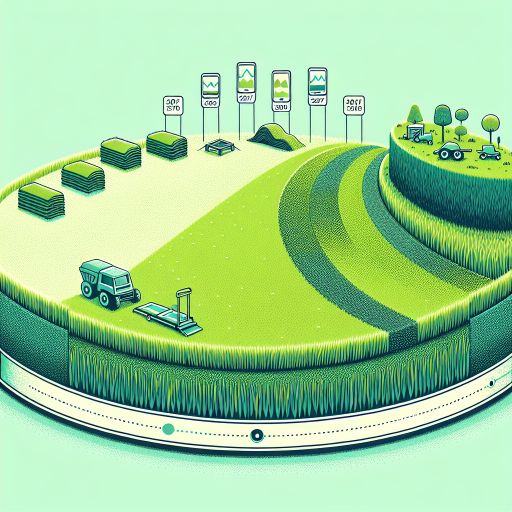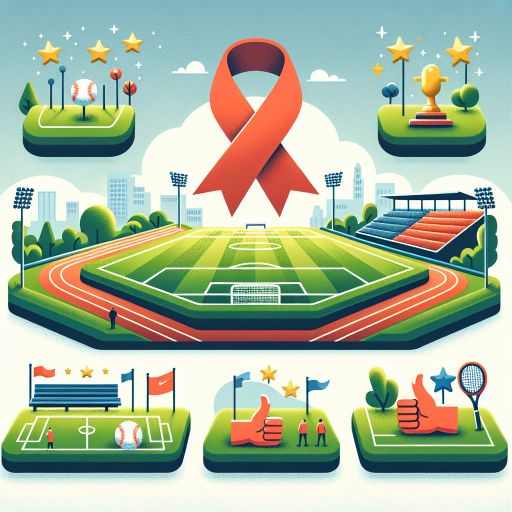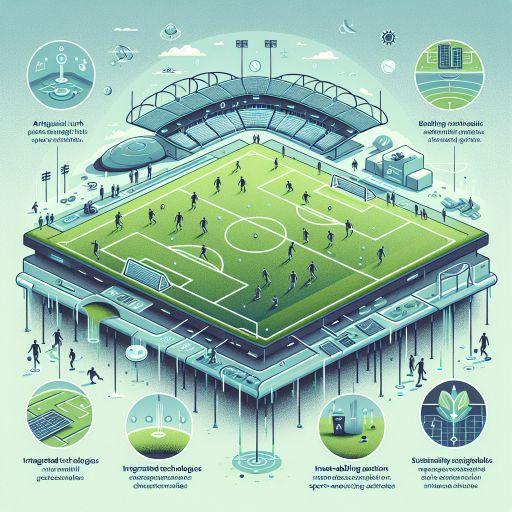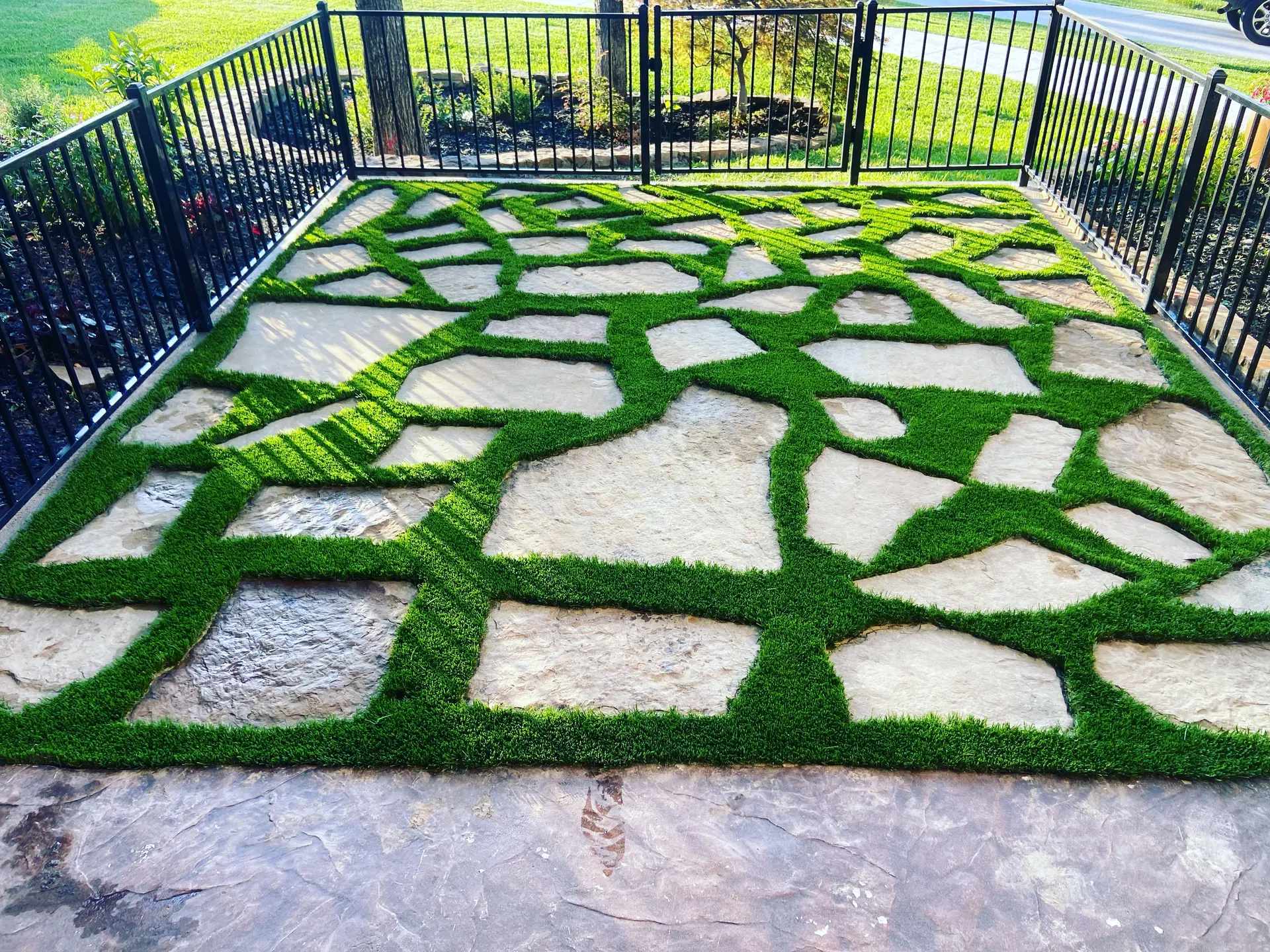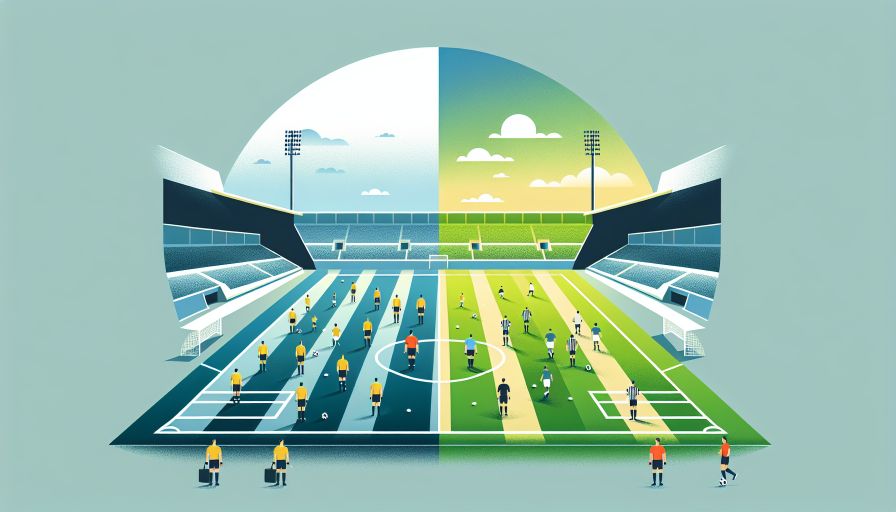
- Introduction to Artificial Grass in Modern Sports Venues
- Historical Development and Evolution of Artificial Grass
- Technological Innovations and Material Science in Artificial Turf
- Environmental and Economic Impacts of Artificial Grass
- Case Studies: Successful Implementations of Artificial Grass in Sports Venues
- Health and Safety Considerations for Athletes
- Future Trends and Developments in Artificial Turf for Sports Venues
Introduction to Artificial Grass in Modern Sports Venues
Artificial grass, also known as synthetic turf, has become a prominent feature in modern athletic facilities. Its adoption is driven by numerous benefits that meet the demands of contemporary sports venues. This chapter delves into the specifics of what artificial grass is and why it has become a crucial element in the design and functionality of sports facilities around the world.
Definition and Composition
Artificial grass is a surface of synthetic fibers that mimics the look and feel of natural grass. Typically, it is made from polyethylene, polypropylene, or nylon, which are then tufted into a backing material. The fibers are often coated with a UV-resistant substance to endure prolonged exposure to sunlight.
Key Benefits
The integration of artificial grass into sports venues offers several key advantages:
- Durability: Artificial turf can withstand more intensive use compared to natural grass, making it suitable for high-frequency activities.
- Maintenance: It requires less upkeep, such as watering, mowing, and fertilizing, which reduces maintenance costs and efforts.
- Weather Resistance: Artificial grass remains functional and aesthetically pleasing under various weather conditions, including heavy rain and extreme temperatures.
- Consistent Playing Surface: It provides a uniform playing field, minimizing irregularities that can affect the game.
Usage Across Sports
Artificial grass is employed in a variety of sports, including:
- Football and Soccer
- Rugby
- Hockey
- Baseball
- Lacrosse
Cost Comparison
The cost implications of installing and maintaining artificial grass versus natural grass are substantial. Below is a basic comparison:
| Aspect | Artificial Grass | Natural Grass |
|---|---|---|
| Initial Installation | High | Medium |
| Yearly Maintenance | Low | High |
| Lifespan | 10-15 years | Varies (Requires more frequent repair) |
Global Adoption
The global adoption of artificial grass in sports venues continues to rise. Countries like the United States, United Kingdom, and Australia have witnessed widespread installations in professional, amateur, and educational settings.
The next chapters will explore the historical development, technological innovations, environmental, and economic impacts of artificial grass, as well as practical case studies and future trends in its application.
Historical Development and Evolution of Artificial Grass
The history of artificial grass dates back to the 1960s when it was first developed as a solution to the challenges faced by natural grass fields in sports venues. The origins of artificial grass can be traced to the introduction of AstroTurf, a brand that became synonymous with synthetic turf, which was installed at the Houston Astrodome in 1966. This early version of artificial grass was primarily made of nylon fibers and required significant maintenance to remain functional.
During the 1970s and 1980s, artificial grass saw widespread adoption across various sports, particularly in North America. Its popularity stemmed from its ability to withstand adverse weather conditions and heavy usage without degrading rapidly. However, these initial installations also highlighted some deficiencies, including issues related to player safety and comfort. The surfaces were criticized for being excessively hard, leading to an increased risk of injuries such as abrasions and joint stress.
In response to these concerns, the 1990s ushered in significant improvements in the design and materials used in artificial grass. One of the major advancements was the introduction of polyethylene blades and infill systems, which helped create a more realistic playing surface. The infill, often comprising sand and rubber granules, provided better cushioning, reduced the impact on athletes, and closely mimicked the feel of natural grass. These improvements addressed many of the safety concerns and made artificial grass more acceptable for a broader range of sports.
The turn of the 21st century marked a period of rapid technological evolution in artificial grass. Innovations in material science led to the development of more durable and realistic fibers, as well as advancements in turf backing systems that improved drainage and stability. As a result, modern artificial grass surfaces can now replicate the performance characteristics of natural grass more accurately than ever before. This has facilitated their adoption in high-profile stadiums and training facilities around the world.
Additionally, the development of hybrid systems, which combine natural grass with synthetic fibers, has further expanded the application of artificial grass. These systems offer the best of both worlds by enhancing the durability and resilience of natural grass while maintaining the aesthetic and performance benefits. Hybrid pitches are now commonly used in elite sports venues, particularly in soccer, rugby, and American football.
Overall, the evolution of artificial grass has been driven by a combination of technological advancements and a growing understanding of the needs and safety of athletes. From its early days as a novel solution to maintenance challenges, artificial grass has transformed into a sophisticated, high-performance surface that plays a crucial role in modern athletic facilities.
Technological Innovations and Material Science in Artificial Turf
Technological advancements and material science have significantly transformed artificial turf, enhancing its suitability and acceptance in modern athletic facilities. The innovations in this field address both performance and safety concerns, making it a viable alternative to natural grass.
Material Composition and Structure
The primary materials used in the production of artificial grass include polyethylene, polypropylene, and nylon. These synthetic fibers are designed for durability, flexibility, and resilience.
| Material | Characteristics |
|---|---|
| Polyethylene | Soft, resilient, and commonly used for its resemblance to natural grass. |
| Polypropylene | Stiffer, suitable for areas with heavy foot traffic or multi-purpose fields. |
| Nylon | Highly durable and strong, often used in combination with other fibers. |
Backing and Infill Systems
Modern artificial turf often incorporates multiple layers, including a backing system and infill materials, which contribute to performance and safety.
- Backings: Typically consist of multi-layered polypropylene or polyurethane, providing the necessary support and stability.
- Infill materials: Commonly used infills include sand, rubber, or a combination of both. Innovations also introduced organic infills like coconut husk and cork for improved environmental benefits.
Technological Innovations
Recent technological advances have led to significant improvements in artificial grass systems:
- Shock Pad Layers: Cushioning layers placed beneath the turf to enhance shock absorption and reduce the risk of injuries.
- UV Stabilization: Enhances the turf’s resistance to ultraviolet rays, prolonging its lifespan and maintaining color integrity.
- Heat Reduction Technologies: Innovations aimed at reducing the surface temperature of artificial turf, making it safer and more comfortable for athletes.
Durability and Maintenance
Enhanced durability is one of the significant benefits of modern artificial turf. Rigorous testing and engineering have led to products that can withstand extensive use while maintaining performance characteristics.
Maintenance practices have also evolved, incorporating techniques like brushing, cleaning, and periodic infill replenishment to retain optimal playing conditions. These practices help extend the turf’s lifespan and ensure it meets the required safety standards.
Environmental and Economic Impacts of Artificial Grass
The use of artificial grass in sports venues has widespread environmental and economic impacts. Understanding these impacts is essential for facility operators, athletes, and policymakers who are considering the integration of synthetic turf in their respective domains.
Environmental Impacts
The environmental implications of artificial grass are multi-faceted, encompassing both positive and negative effects. One of the main advantages is the reduction in water usage. Natural grass sports fields often require substantial amounts of water for maintenance. In contrast, artificial turf does not demand such extensive irrigation, making it a more sustainable option in regions facing water scarcity.
Another significant environmental benefit is the reduction in the use of pesticides and fertilizers. Natural grass fields typically need these chemicals to maintain their aesthetic and functional quality, which can lead to run-offs and contamination of local water supplies. Artificial grass eliminates the need for such chemicals, thereby reducing potential environmental contamination.
However, the production and disposal of artificial grass do have negative environmental impacts. The manufacturing process involves the use of plastics and other non-biodegradable materials, contributing to pollution and resource depletion. Additionally, when artificial turf reaches the end of its lifecycle, disposal becomes a challenge due to the difficulty in recycling synthetic materials. Incineration or landfill disposal can lead to further environmental degradation.
Economic Impacts
The economic repercussions of installing artificial grass are equally noteworthy. Initially, the cost of installing synthetic turf can be higher compared to natural grass. However, the long-term economic benefits often outweigh these initial expenditures. Artificial grass typically has a lifespan of 8 to 15 years, during which maintenance costs are significantly lower than those for natural grass. These lower maintenance costs include savings on water, mowing, fertilizing, and pest control.
Moreover, artificial grass allows for extended use of sports venues, maximizing revenue opportunities. Natural grass fields often require downtime for recovery and maintenance, limiting their availability. Synthetic turf, on the other hand, can withstand frequent use without deteriorating, making it possible to host more events, practices, and games. This increased utilization translates to higher revenue streams for facility operators.
Artificial grass also creates other indirect economic benefits. For instance, its consistent playing surface reduces injury-related costs. A stable and uniform surface decreases the likelihood of injuries caused by uneven ground, which can result in fewer medical expenses and reduced downtime for athletes.
Conclusion
The environmental and economic impacts of artificial grass are complex and multifaceted, involving both benefits and drawbacks. By reducing water consumption and eliminating the need for harmful chemicals, artificial grass offers notable environmental advantages. Economic considerations also favor synthetic turf, with long-term maintenance savings and increased facility usage presenting compelling arguments for its adoption. Balancing these impacts is key for stakeholders aiming to make informed decisions about the integration of artificial grass in modern sports venues.
Case Studies: Successful Implementations of Artificial Grass in Sports Venues
Artificial grass has been implemented successfully in numerous sports venues around the world, showcasing its versatility and benefits. These real-world examples highlight how artificial turf has been integrated into modern athletic facilities to provide high-quality playing surfaces.
FIFA World Cup Venues
Several stadiums used during FIFA World Cup events have incorporated artificial grass to ensure consistent performance. For instance:
- 2010 FIFA World Cup: South Africa’s Port Elizabeth Stadium used a combination of natural grass and artificial fibers, creating a hybrid surface known as Desso GrassMaster. This technology provided better durability and reduced maintenance requirements.
- 2015 FIFA Women’s World Cup: Held in Canada, this tournament exclusively used artificial turf across all venues, highlighting the adaptability of artificial grass for major international events. The artificial turf provided a consistent playing surface across different climatic conditions.
National Football League (NFL) Stadiums
In the United States, several NFL stadiums have adopted artificial grass to meet the demanding requirements of professional football.
- AT&T Stadium: Home of the Dallas Cowboys, this stadium features Hellas Matrix Turf with Helix technology. The artificial turf system provides a stable and resilient surface, enhancing player performance and safety.
- MetLife Stadium: Hosting both the New York Giants and New York Jets, MetLife Stadium uses the UBU Sports Speed Series S5-M synthetic turf system. The surface is designed to mimic the natural movement of grass, providing a realistic playing experience.
Olympic Venues
The Olympic Games have also seen the adoption of artificial grass in various disciplines.
- 2016 Rio Olympics Hockey Centre: The hockey fields at the Deodoro Olympic Park featured Poligras Platinum, a synthetic turf specifically designed for field hockey. The surface ensured optimal ball roll and consistent playing conditions, contributing to high-level competition.
Wimbledon
Although primarily known for its natural grass courts, Wimbledon has integrated artificial grass for training purposes. The All England Club uses artificial turf in its practice courts to replicate the conditions of the main courts while reducing wear and maintenance needs on the natural grass surfaces.
Community and Educational Facilities
Artificial grass is not limited to professional venues. Many community sports fields and educational institutions have adopted artificial turf to maximize usage and reduce upkeep.
- New York City’s Randall’s Island: Hosting various athletic events, this park has multiple fields with FieldTurf, providing durable and versatile surfaces for soccer, baseball, and other sports.
- University of Oregon’s Autzen Stadium: Featuring FieldTurf Revolution 360, this stadium ensures a consistent and high-quality playing field for the university’s football team, enabling extensive use year-round.
The successful implementation of artificial grass in these venues underscores its effectiveness and advantages. From professional stadiums to local community fields, artificial turf provides reliable, high-performance surfaces that meet the diverse needs of different sports and events.
Health and Safety Considerations for Athletes
The health and safety of athletes are paramount considerations when evaluating the use of artificial grass in sports venues. Research has shown that artificial grass can potentially affect players in various ways, both positively and negatively. It is important to assess these factors comprehensively to ensure a balanced understanding of its implications.
Injury Risk: One of the chief concerns with artificial grass is its association with certain types of injuries. According to studies, athletes playing on artificial turf are at a higher risk for non-contact injuries like anterior cruciate ligament (ACL) tears. The increased friction and resistance offered by synthetic surfaces can lead to more frequent injuries, particularly in high-impact sports such as football and soccer.
Heat Exposure: Artificial grass tends to retain more heat than natural grass, which can surface temperatures to rise significantly. Research from Penn State University has reported that artificial turf surfaces can get up to 60 degrees Fahrenheit hotter than natural grass. High surface temperatures can not only affect player performance but also increase the risk of heat-related illnesses.
Surface Uniformity: One significant advantage of artificial grass is its consistent playing surface. Unlike natural grass, which can develop uneven patches and holes that pose tripping hazards, artificial grass provides uniformity that can potentially reduce accidental falls and related injuries.
Microbial Concerns: There have been some concerns with the microbial life harbored in artificial turf. A study published in the ‘Journal of Applied Microbiology’ found that synthetic surfaces could potentially host harmful bacteria, including Methicillin-resistant Staphylococcus aureus (MRSA). This risk underscores the importance of regular maintenance and sanitization of artificial turf.
Allergen Impact: An advantage of artificial grass is the reduction in allergens. Natural grass can harbor pollen and other allergens that may affect sensitive individuals. Artificial turf, on the other hand, does not produce pollen, offering a hypoallergenic playing environment.
Comfort and Performance: Advancements in artificial grass technology have led to the development of surfaces designed to mimic the comfort and performance characteristics of natural grass. Modern artificial turfs incorporate shock-absorbing materials to reduce impact on joints and improve overall player comfort.
Mitigation Strategies: To address these health and safety concerns, various mitigation strategies have been implemented. Regular maintenance and proper sanitation are critical to preventing microbial contamination. Moreover, newer artificial grass designs incorporate cooling technologies, such as infill materials designed to reduce heat retention.
In conclusion, while artificial grass offers numerous benefits for sports venues, it is crucial to carefully consider and address the associated health and safety concerns. Ensuring the well-being of athletes requires a balanced approach that incorporates both cutting-edge technology and diligent maintenance practices.
Future Trends and Developments in Artificial Turf for Sports Venues
The future of artificial turf in sports venues is set to be influenced by several emerging trends and technological advancements. As the demand for high-performance and sustainable sports surfaces increases, manufacturers and researchers are focusing on innovative materials and designs to meet these evolving needs.
Improved Durability and Performance: Advances in polymer science are leading to the development of artificial grass that is more resilient and longer-lasting. New fiber technologies are being designed to withstand intense usage, reducing the need for frequent replacements and maintenance. Additionally, innovations such as multi-layered backing systems and enhanced UV stabilizers help in maintaining turf quality over extended periods.
Enhanced Player Safety: Future designs are heavily focused on improving player safety. Research is being directed towards producing turf systems that better mimic the natural playability and impact absorption characteristics of natural grass. This includes the development of shock-absorbent infill materials and fibers that reduce the risk of injuries associated with sports activities.
Environmental Sustainability: Sustainability remains a key concern for artificial turf manufacturers. Innovations are being introduced to make artificial grass more eco-friendly. This includes the use of recyclable and biodegradable materials, as well as advanced infill options made from organic and sustainable sources. Water-saving technologies are also being integrated to further enhance the environmental profiles of these surfaces.
Smart Turf Systems: The integration of smart technologies into artificial turf is an exciting development. This trend includes the embedding of sensors within the turf to monitor parameters such as surface temperature, player activity, and wear patterns. These data-driven insights can help facility managers optimize maintenance schedules and improve the overall user experience.
Customization and Aesthetics: Another future trend is the increasing ability to customize artificial turf surfaces to meet specific needs. This includes tailored solutions for different sports, climate conditions, and aesthetic preferences. Manufacturers are investing in R&D to offer a variety of color options, fiber lengths, and infill types that can be adapted to both functional and aesthetic requirements.
In conclusion, the future of artificial turf in sports venues is poised for significant advancements. By focusing on durability, safety, sustainability, smart technology, and customization, the industry aims to meet the rising expectations of athletes, facility managers, and environmental advocates alike.
